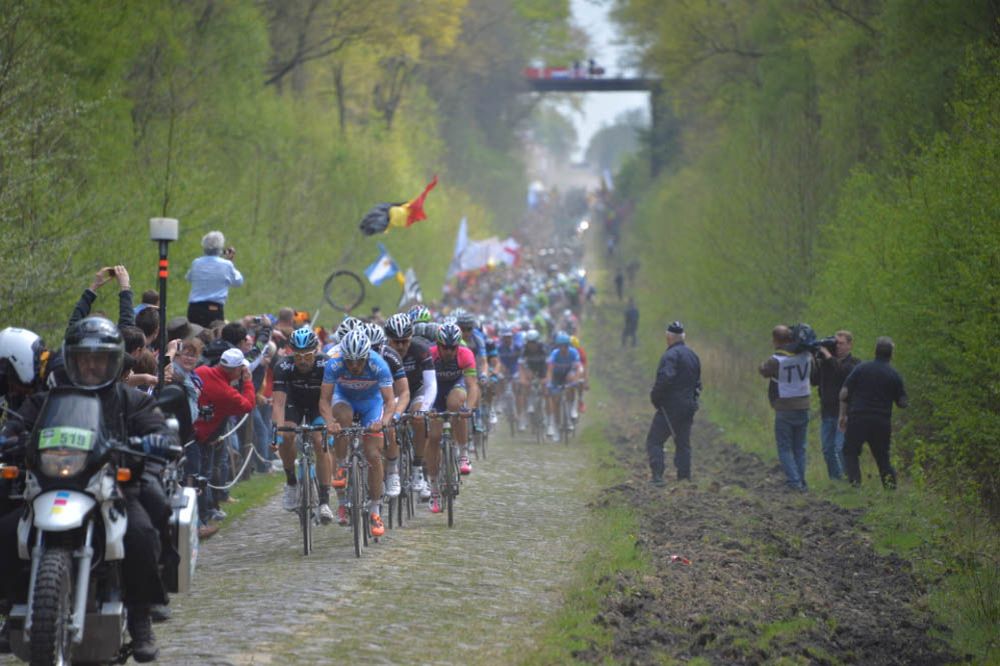Paris-Roubaix: Terpstra’s victory, Canadians troubled by punctures and a crash
Niki Terpstra’s winning attack with 6 km to go in yesterday’s Paris-Roubaix came after a dramatic day of racing in the fields of northern France.


Niki Terpstra’s winning attack with 6km to go in yesterday’s Paris-Roubaix came after a dramatic day of racing in the fields of northern France. With stiff winds and 28 sectors of cobbles to contend with over the famous 257km course, the peloton set out from Compiègnes knowing they were in for a formidable contest. Over the next six hours, the script would be ripped up and re-written over and over in what turned out to be one of the most riveting editions of the classic in recent memory.
Tim de Troyer, David Boucher, Michael Kolar, Clément Koretzky, Kenny Dehaes, Andreas Schillinger, John Murphy and Benoit Jarrier went on the attack early to form the traditional breakaway. Their advantage quickly stretched out to nine minutes, while the peloton rolled tensely behind.
The gap began to come down slowly as Belkin, Trek, and Omega Pharma-Quick-Step took up the chase. Team Sky broke the stalemate on the approach to the Trouée d’Arenberg, driving hard to split the peloton in a cross-wind section. The break came apart in the Forest of Arenberg, losing four riders to mishaps. By the end of the trench their gap had dwindled to four-and- a-half minutes. Murphy, De Troyer, Jarrier and Schillinger were left in the lead.
The peloton remained largely intact on its passage through the trench. Alexander Kristoff was the only favourite to suffer real trouble, losing more than a minute to a crash. He would soon crash again and climb into his team car.
Soon after d’Arenberg, a pile-up took out a huge swathe of the peloton, with Fabian Cancellara and Peter Sagan included in the mess.
Omega Pharma-Quick-Step quickly dropped the hammer, smashing the field into pieces in the wind. After wrecking significant damage, the Belgian squad finally let off to assess the effects of their work. Taking advantage of this hesitation, a group of 12 slipped off the front
The peloton allowed them to dangle for a few kilometres, then, on the next section of cobbles ,Tom Boonen made a powerful solo attack to bridge to the move.
He arrived to a group of unwilling break-mates. Only Geraint Thomas was willing to ride with the overeager Belgian. Boonen drove hard on the front, blowing by the early breakaway with 61km left to race. However, he was clearly frustrated by the others’ lack of effort. He yelled and gestured and attacked several times but could not shake the defensive group.
Then, Thor Hushovd played a card, attacking the peloton to come across alone to the move containing Boonen. In Hushovd, Boonen found a willing partner. The two strong men drove hard on the front of the attack while Belkin lead the chase behind.
For a long stretch, it seemed as if Boonen’s group might crack their pursuers. The group behind had swelled in number to include several big names, including Cancellara, Wiggins, and Sagan butfew teams were well represented and everyone was tiring. The gap stretched out to a minute, only to close, then open again several times.
With 38km to go, Sep Vanmarke drew out the favourites in the field with a hard attack on the cobbles. Again, no one was willing to ride and the move did not stick.
Then, Peter Sagan, who had been mostly invisible for the preceding 70km, launched an attack from the bunch with Martin Wynandts on his wheel.The Slovak put in a huge effort to bridge, while, in front, Boonen made several failed attempts to go it alone.
Sagan made it across, then with 21km to go, launched a potent solo attack. He built up a significant lead and was still alone going onto the difficult Carrefour de l’Arbre sector of pave with 16km to race.
There, the group made the close, with Vanmarke, Cancellara, Degenkolb, and Stybar breaking free, while Boonen, Terpstra, Thomas, Sagan, Wiggins, Langeveld, and De Backer fought to make contact.
With 8km to go, they made the close, and it looked as if the biggest group in many years would decide the race in a bunch sprint on the Roubaix velodrome.
The favourites eyed each other, Bradley Wiggins had a vain go, then, with perfect-timing, Niki Terpstra launched his attack out of a round-about and was away, holding on solo for the final six kilometres to win Paris-Roubaix, the biggest victory of his career. Behind, John Degenkolb won the sprint for second. Fabian Cancellara was third.
Canadian, Hugo Houle of AG2R La Mondiale had a tough day but managed to make it to the finish in Roubaix. The native of Trois-Rivieres, Quebec set out to protect his teammate Damien Gaudin late into the race, but suffered from two untimely punctures; first, on the Haveluy sector of pave immediately before the Trouée d’Arenberg then soon after when the race was at full-throttle in the cross winds. He found himself in a group of 15 riding towards the finish but half of that group climbed off when they reached the second feed-zone. Houle soldiered on, struggling over the final sectors of cobblestones “Sometimes, I asked myself, just what am I doing out here?” said Houle “But then all of the fans gave me motivation.” His group picked up other trailing riders before finally arriving in the famous velodrome to finish one of the hardest classics in the sport of cycling. His next races will be the Tour du Finistère and Tro-Bro Léon.
The other Canadian in the race, Antoine Duchesne, suffered from even worse luck, hitting a pole after sector 20 to finish his race in the hospital. He will being taking a few days off of the bike.
